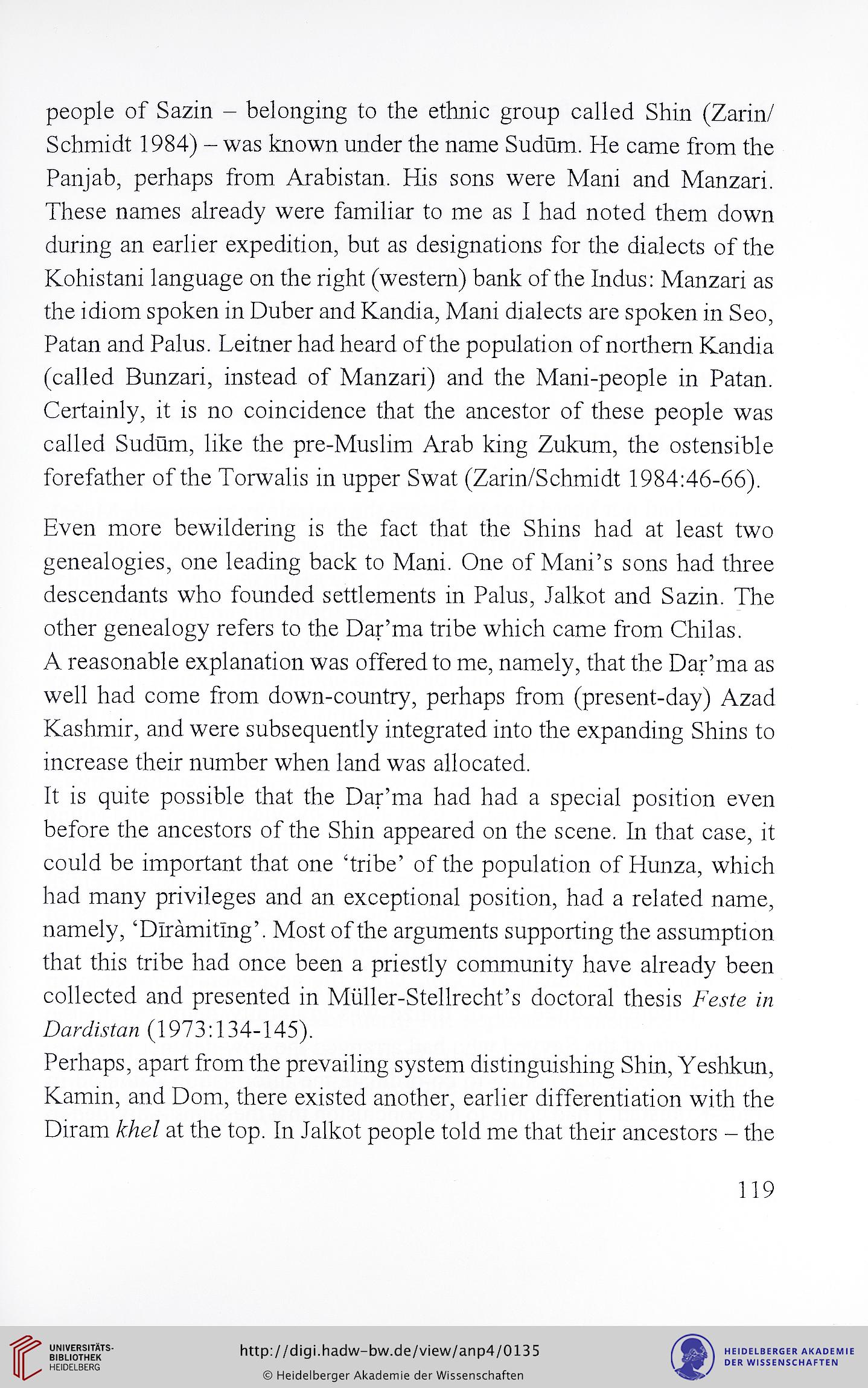people of Sazm - belonging to the ethnic group called Shin (Zarin/
Schmidt 1984) - was known under the name Sudum. He came from the
Panjab, perhaps from Arabistan. His sons were Mani and Manzari.
These names already were familiar to me as I had noted them down
during an earlier expedition, but as designations for the dialects of the
Kohistani language on the right (western) bank of the Indus: Manzari as
the idiom spoken in Duber and Kandia, Mani dialects are spoken in Seo,
Patan and Palus. Leitner had heard of the population of northern Kandia
(called Bunzari, instead of Manzari) and the Mani-people in Patan.
Certainly, it is no coincidence that the ancestor of these people was
called Sudum, like the pre-Muslim Arab king Zukum, the ostensible
forefather of the Torwalis in upper Swat (Zarin/Schmidt 1984:46-66).
Even more bewildering is the fact that the Shins had at least two
genealogies, one leading back to Mani. One of ManPs sons had three
descendants who founded settlements in Palus, Jalkot and Sazin. The
other genealogy refers to the Dar'ma tribe which came from Chilas.
A reasonable explanation was offered to me, namely, that the Dar'ma as
well had come from down-country, perhaps from (present-day) Azad
Kashmir, and were subsequently integrated into the expanding Shins to
increase their number when land was allocated.
It is quite possible that the Dar'ma had had a special position even
before the ancestors of the Shin appeared on the scene. In that case, it
could be important that one 'tribe' of the population of Hunza, which
had many privileges and an exceptional position, had a related name,
namely, 'Dlramiting'. Most of the arguments supporting the assumption
that this tribe had once been a priestly community have already been
collected and presented in Muller-Stellrecht's doctoral thesis Fus-tg hi
DuMAhu? (1973:134-145).
Perhaps, apart from the prevailing system distinguishing Shin, Yeshkun,
Kamin, and Dom, there existed another, earlier differentiation with the
Diram at the top. In Jalkot people told me that their ancestors - the
119
Schmidt 1984) - was known under the name Sudum. He came from the
Panjab, perhaps from Arabistan. His sons were Mani and Manzari.
These names already were familiar to me as I had noted them down
during an earlier expedition, but as designations for the dialects of the
Kohistani language on the right (western) bank of the Indus: Manzari as
the idiom spoken in Duber and Kandia, Mani dialects are spoken in Seo,
Patan and Palus. Leitner had heard of the population of northern Kandia
(called Bunzari, instead of Manzari) and the Mani-people in Patan.
Certainly, it is no coincidence that the ancestor of these people was
called Sudum, like the pre-Muslim Arab king Zukum, the ostensible
forefather of the Torwalis in upper Swat (Zarin/Schmidt 1984:46-66).
Even more bewildering is the fact that the Shins had at least two
genealogies, one leading back to Mani. One of ManPs sons had three
descendants who founded settlements in Palus, Jalkot and Sazin. The
other genealogy refers to the Dar'ma tribe which came from Chilas.
A reasonable explanation was offered to me, namely, that the Dar'ma as
well had come from down-country, perhaps from (present-day) Azad
Kashmir, and were subsequently integrated into the expanding Shins to
increase their number when land was allocated.
It is quite possible that the Dar'ma had had a special position even
before the ancestors of the Shin appeared on the scene. In that case, it
could be important that one 'tribe' of the population of Hunza, which
had many privileges and an exceptional position, had a related name,
namely, 'Dlramiting'. Most of the arguments supporting the assumption
that this tribe had once been a priestly community have already been
collected and presented in Muller-Stellrecht's doctoral thesis Fus-tg hi
DuMAhu? (1973:134-145).
Perhaps, apart from the prevailing system distinguishing Shin, Yeshkun,
Kamin, and Dom, there existed another, earlier differentiation with the
Diram at the top. In Jalkot people told me that their ancestors - the
119




